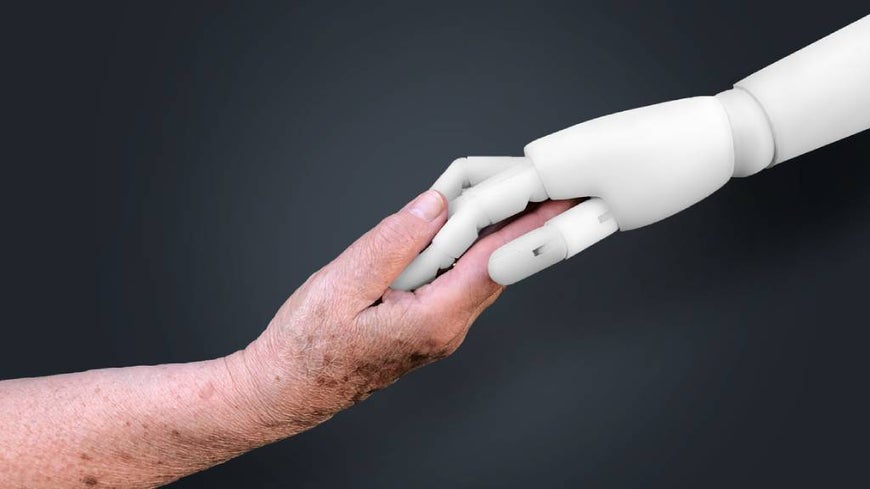The future is here – robots in aged care

Written by Stephen Corby and James Jennings for Australian Seniors.
It’s fair to say robots – as opposed to toasters, blenders, vacuum cleaners and other labour-saving devices – have a slightly scary reputation. While many of us now accept virtual helpers such as Google Assistant, Siri and Alexa in our lives, the idea of a larger, more human-like and arguably more useful robot version in the house can be confronting.
Rather than think of faithful sci-fi servants in the Star Wars C-3PO or R2-D2 mode, we tend to default to malevolent machines hellbent on destroying mankind. It dates back to 1920, when Czech writer Karel Capek coined ‘robot’ (derived from a Czech word for ‘forced worker’) for his play about factory-made automatons that rise up and kill humans. It’s the kind of bad press that creates an unfair bias against real robots, created to make your life a bit easier rather than disintegrate you with a ray gun.
“It’s very unfortunate that we’ve all got this jaundiced view of robots and artificial intelligence [AI],” says Nicci Rossouw, CEO of Exaptec, a Melbourne-based company that specialises in providing robots to Australian customers. “The reality is that robots are extremely useful tools that can enable older people to live in their homes longer than they could have without the use of technology.”
The robots that are helping already
Japanese company Toyota has been developing robots since the 1970s, with a Partner Robot division founded in 2005. Partner Robots are designed to assist people with mobility and various activities in the areas of nursing and healthcare, home-living assistance and personal transport.
Toyota’s Human Support Robot (HSR) has been created with care for the elderly in mind. The compact, manoeuvrable and lightweight robot has a folding arm capable of picking objects off the floor, retrieving items off shelves and other tasks to assist with independent living. The voice or tablet-controlled HSR can be classified as a ‘service robot’ due to its ability to assist with household tasks, but it’s also a ‘telepresence robot’, as it can perform video calls on its screen.
Both types of robots are already available in Australia, although you might not have seen one yet yourself (with the exception of the now common Roomba, a robotic vacuum cleaner). Exaptec offers a variety of models, including Temi, which bills itself as “the world’s first truly intelligent, mobile, personal robot for your home”.
“Temi can communicate in 18 different languages and is Alexa-integrated, and you can map this little robot, which basically means that you can set it on a program to drive around your house, from the kitchen to the lounge to the study,” Nicci explains.
Which would come into its own for offspring worried about their parents. The robots can be put on auto-answer, so if Nicci’s mother didn’t answer a call, “I could actually drive the little robot around her house and find out where she is. It’s essentially a piece of technology, much like your mobile phone, that’s designed to make your life a lot easier.”
Therapy robots
Besides telepresence and service robots, there are also ‘social robots’, which have been used in scenarios ranging from providing company and entertainment in aged care homes to assisting those with dementia. A therapeutic robotic baby harp seal named Paro, which responds to sound and touch, has proven hugely popular, with hundreds of them in use in aged care facilities around Australia.
“Paro has been really effective, with emerging evidence from Australia, New Zealand and a few other countries that demonstrates it’s helpful in alleviating some symptoms of loneliness for individuals and for older adults with dementia,” says Emily Cross, Professor of Neuroscience at Macquarie University, who is researching what happens in the brain when people socialise with robots.
Privacy concerns
Introducing a robot into the home can also create concerns around safety and privacy – something that’s been front-of-mind for Ian Oppermann, Industry Professor at the University of Technology Sydney (UTS) and a NSW government chief data scientist.
He says UTS has been working with the CSIRO to discuss issues regarding enabling aged care in the home, but admits there’s still a way to go when it comes to unravelling the legal and moral complications that arise when robots and AI are placed with the elderly – especially those living with dementia.
“There is going to have to be some really serious considerations when it comes to issues like privacy, security and meaningful forms of consent,” he says. “If you put devices into someone’s home, you impact all three of those things immediately.”
The future is here
Regardless of these hurdles, Exaptec’s Nicci reckons now is the time to start adopting robotic technology. “I think, typically, Australians are a little bit risk averse, but this is technology that should be pushed,” she says.
And there’s little chance that robots will ‘take over’. According to Professor Cross, old-fashioned human relationships that aren’t reliant on sensors, radar and AI will always take precedence, even if robots can lend us a plastic hand to help make our lives easier.
“It’s more about offloading some of the tasks that people might find difficult, like lifting people in and out of beds or wheelchairs, while still having meaningful person-to-person relationships with human carers. But if we can stave off a little bit of loneliness or a little bit of isolation with robots, or make difficult tasks a lot simpler, that’s great for everyone involved.”
23 Feb 2022